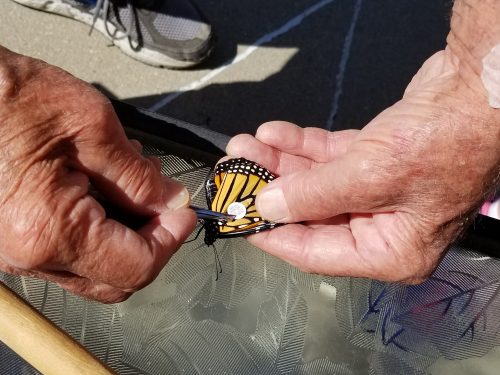Article & photos by Marci Narum
On a warm, sunny Saturday afternoon in early September 2018, Merle Bennett catches the last monarch butterflies of the summer. His backyard in north Bismarck is a choice stop for the beautiful creatures; it’s filled with an assortment of plants and flowers to attract birds and butterflies, including the butterfly bush, which isn’t even meant to withstand North Dakota’s cold climate. It survives because of the tender care Merle gives it.
With his butterfly net in the ready-to-swing position, he moves stealth-like toward some flowers where monarchs have stopped to rest, but even a veteran butterfly catcher like Merle misses from time to time.
“Oh shoot, I missed ‘em. I wasn’t fast enough,” Merle chuckles.
Merle is catching the butterflies for research. The 87-year-old retiree once worked for conservation organizations but never had much interest in butterflies — until his grandson Lucas found the larvae on some milkweed growing near his front porch.
“I knew I had some monarchs around but I didn’t pay much attention. Lucas would be out on the front step playing with the larvae, letting them crawl on his arms, and then one day he was sitting out there and he watched two adult monarch hatch from their cocoons. So, I decided to just keep the milkweed there,” Merle says. As Merle explains, milkweed is critical to the survival of the monarch. The larvae eat the plant exclusively and monarchs lay their eggs only on milkweed. For several years, Merle has enjoyed a close-up experience of the monarch’s entire lifecycle.
“The female lays 100 to 200 eggs, but usually only one or two eggs on any given plant,” Merle explains. “When the egg is laid, it’s just a speck — smaller than a pinpoint, like an olive-colored dot. The egg hatches after about four to six days to become the larvae and feasts on milkweed leaves for about 10-14 days, growing rapidly to almost the size of a child’s little finger.”
Merle sees the larvae spin its web, attach itself to a leaf or other object for protection, and then transform into the bright green chrysalis. “The chrysalis hangs for another 10-14 days and then the brightly-colored adult monarch butterfly emerges. When they first hatch, their wings are like wet noodles. After a few hours in the sun and wind, the wings harden and the butterfly is on its way.”
TAG AND RELEASE
Catching monarchs is part of a tagging program borne over concerns about the declining monarch population. When Merle learned about the Monarch Watch research project at the University of Kansas, he signed up. That was seven years ago.
“I get more than 100 through here in a day during the peak migration period in late August and early September. It goes on all day,” Merle explains. “I tag for a couple hours after lunch and catch maybe 10 or 15 in a day. I don’t disturb them that long. I just let them go.”
But not before he attaches a tiny button-like tag to their wings. Merle determines whether the monarch is male or female (the male has two black dots on its hind wings while the female has none) and then he turns them loose.
“The tagging determines the migration routes,” Merle explains. “There are two population of monarchs. The western population is found west of the Rocky Mountains, and they winter along the coast of California. This eastern population is found east of the Rocky Mountains and covers all of central and eastern United States and southern Canada.”
Merle says the monarchs winter in a forested mountain area west of Mexico City where the Mexican government has set aside several sanctuaries just for the monarchs.
“A lot of them die right there,” Merle says. “When [the people] are cleaning things up after the migration has left, Mexican children go looking for the monarchs with tags, and if they find one, they get a reward. So, that’s how the university gets most of their tags back. Other people are tagging in South Dakota, Nebraska, Colorado, and Oklahoma, and they might catch one that I have tagged.”
An ID number and the phone number of Monarch Watch are printed on the tag, so if someone finds one of those monarchs, Merle will be notified. He hasn’t been notified yet, but he’s not discouraged.
HEADING NORTH

In February, the monarchs start the migration back north. The monarchs in Merle’s yard — any that we see in the Northern Plains in the summer — are a generation of butterflies that live the longest.
“They will start slowly moving back to northern Mexico and southern Texas. And then they mate and lay eggs down there because the milkweed is already growing there. The ones I’ve tagged die,” Merle says. “They just hatched here in the last month. They fly to Mexico, spend the winter, start back, lay their eggs, and then they die.
“And then the next generation moves back up through Oklahoma and Kansas. They mate, lay their eggs on a bunch of milkweed and then they die. And then that next generations comes up here, and we get them in the middle of summer — mating, hatching. Several generations live for only about a month and this generation that we tag lives for about seven or eight months.
“How every one of those monarchs traveling to the sanctuary areas in Mexico — having never been there before — are able to make that long migration to the same areas every year is a scientific puzzle.”
Merle says even he doesn’t know the answer to why he’s still catching monarchs after all these years. He says it started “by accident.” But, considering the butterfly often represents resurrection and new life, it’s evident there is purpose in what Merle is doing. He tenderly cares for his plants and flowers, making his backyard a welcoming sanctuary to new life every summer.
